Professional Skills for Information Technology
VerifiedAdded on 2023/06/12
|18
|3490
|51
AI Summary
This report discusses the recent developments in 3D printing technology and its applications in various industries. It evaluates the pros and cons of the technology and provides recommendations for its implementation.
Contribute Materials
Your contribution can guide someone’s learning journey. Share your
documents today.
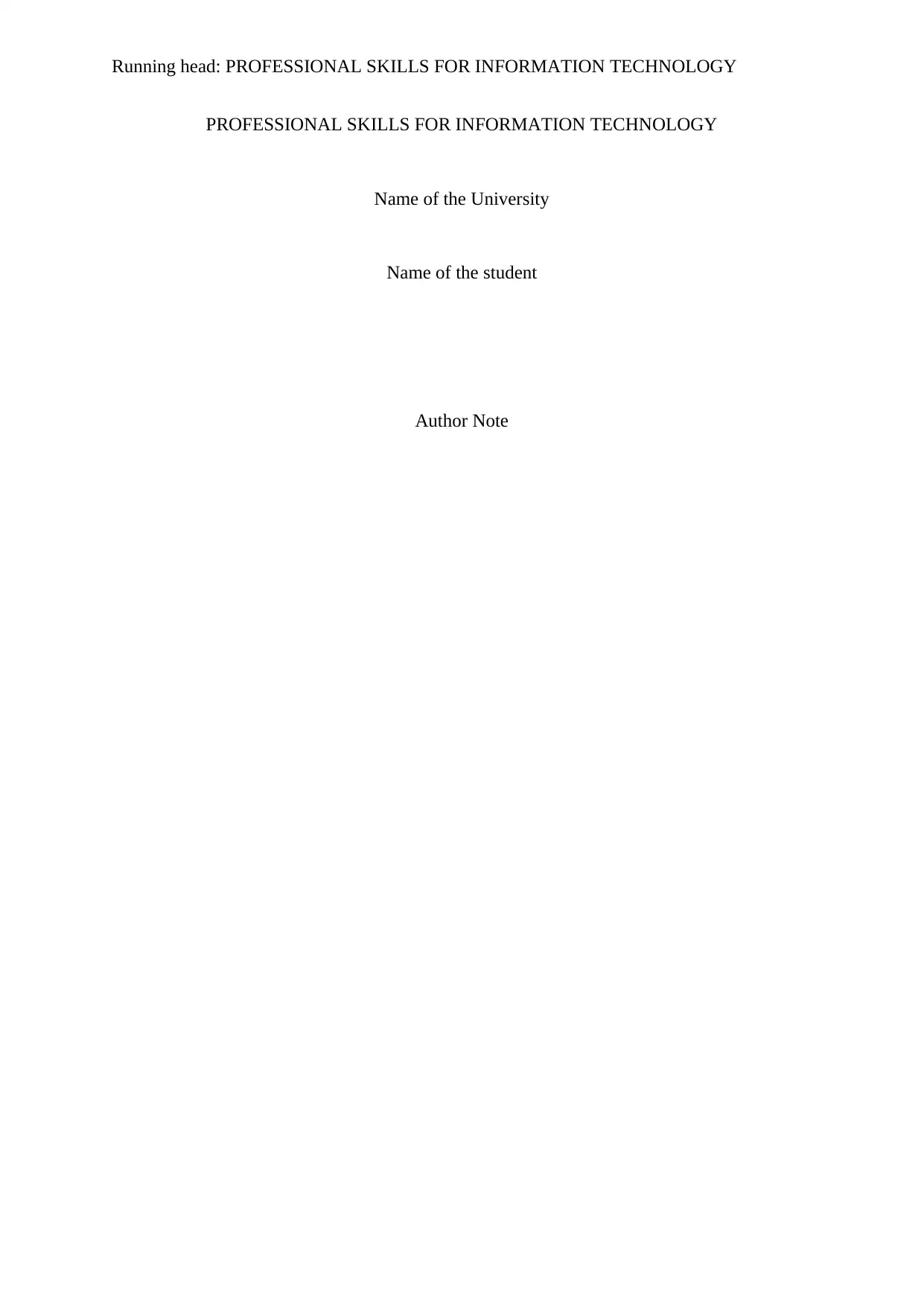
Running head: PROFESSIONAL SKILLS FOR INFORMATION TECHNOLOGY
PROFESSIONAL SKILLS FOR INFORMATION TECHNOLOGY
Name of the University
Name of the student
Author Note
PROFESSIONAL SKILLS FOR INFORMATION TECHNOLOGY
Name of the University
Name of the student
Author Note
Secure Best Marks with AI Grader
Need help grading? Try our AI Grader for instant feedback on your assignments.
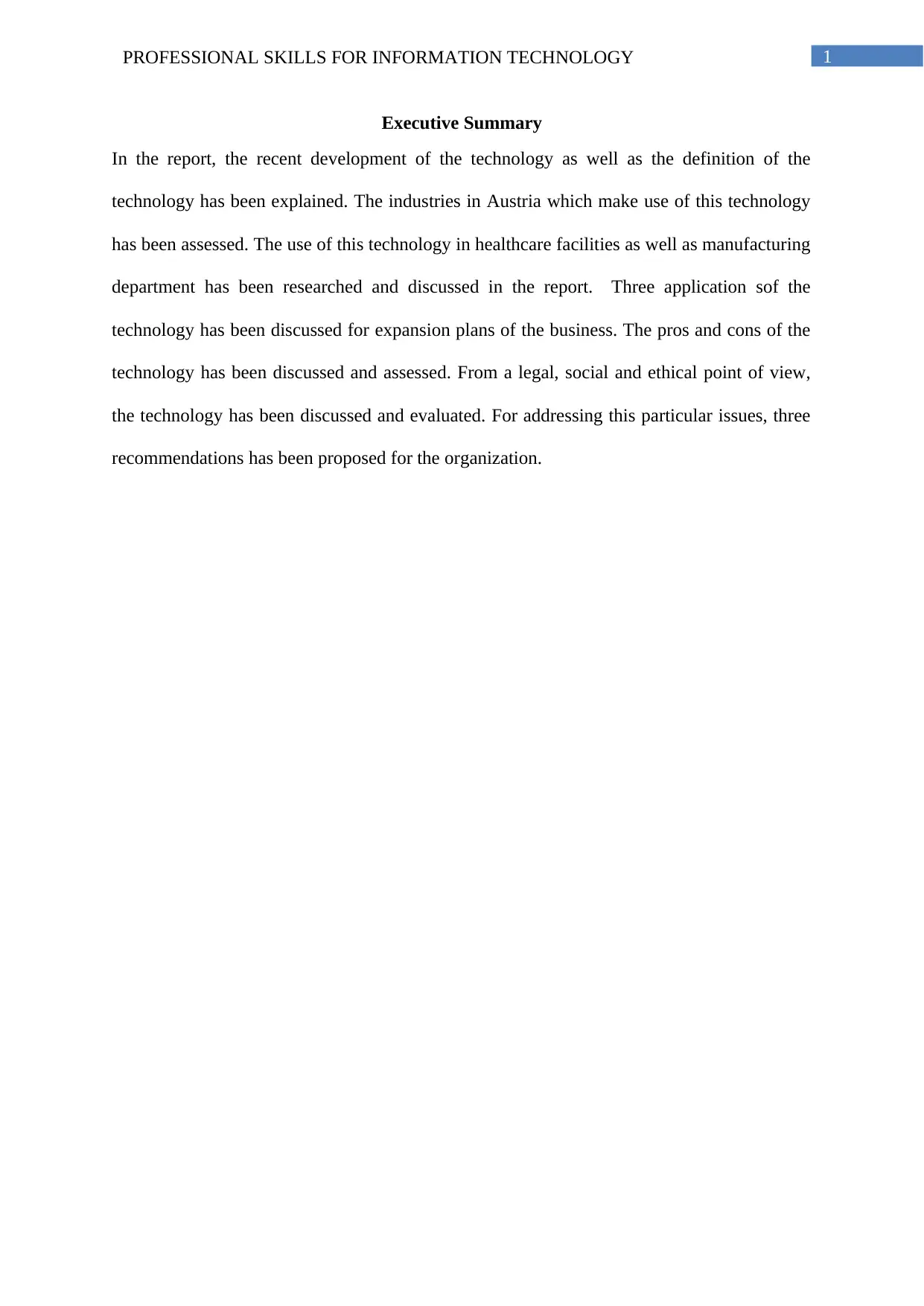
1PROFESSIONAL SKILLS FOR INFORMATION TECHNOLOGY
Executive Summary
In the report, the recent development of the technology as well as the definition of the
technology has been explained. The industries in Austria which make use of this technology
has been assessed. The use of this technology in healthcare facilities as well as manufacturing
department has been researched and discussed in the report. Three application sof the
technology has been discussed for expansion plans of the business. The pros and cons of the
technology has been discussed and assessed. From a legal, social and ethical point of view,
the technology has been discussed and evaluated. For addressing this particular issues, three
recommendations has been proposed for the organization.
Executive Summary
In the report, the recent development of the technology as well as the definition of the
technology has been explained. The industries in Austria which make use of this technology
has been assessed. The use of this technology in healthcare facilities as well as manufacturing
department has been researched and discussed in the report. Three application sof the
technology has been discussed for expansion plans of the business. The pros and cons of the
technology has been discussed and assessed. From a legal, social and ethical point of view,
the technology has been discussed and evaluated. For addressing this particular issues, three
recommendations has been proposed for the organization.
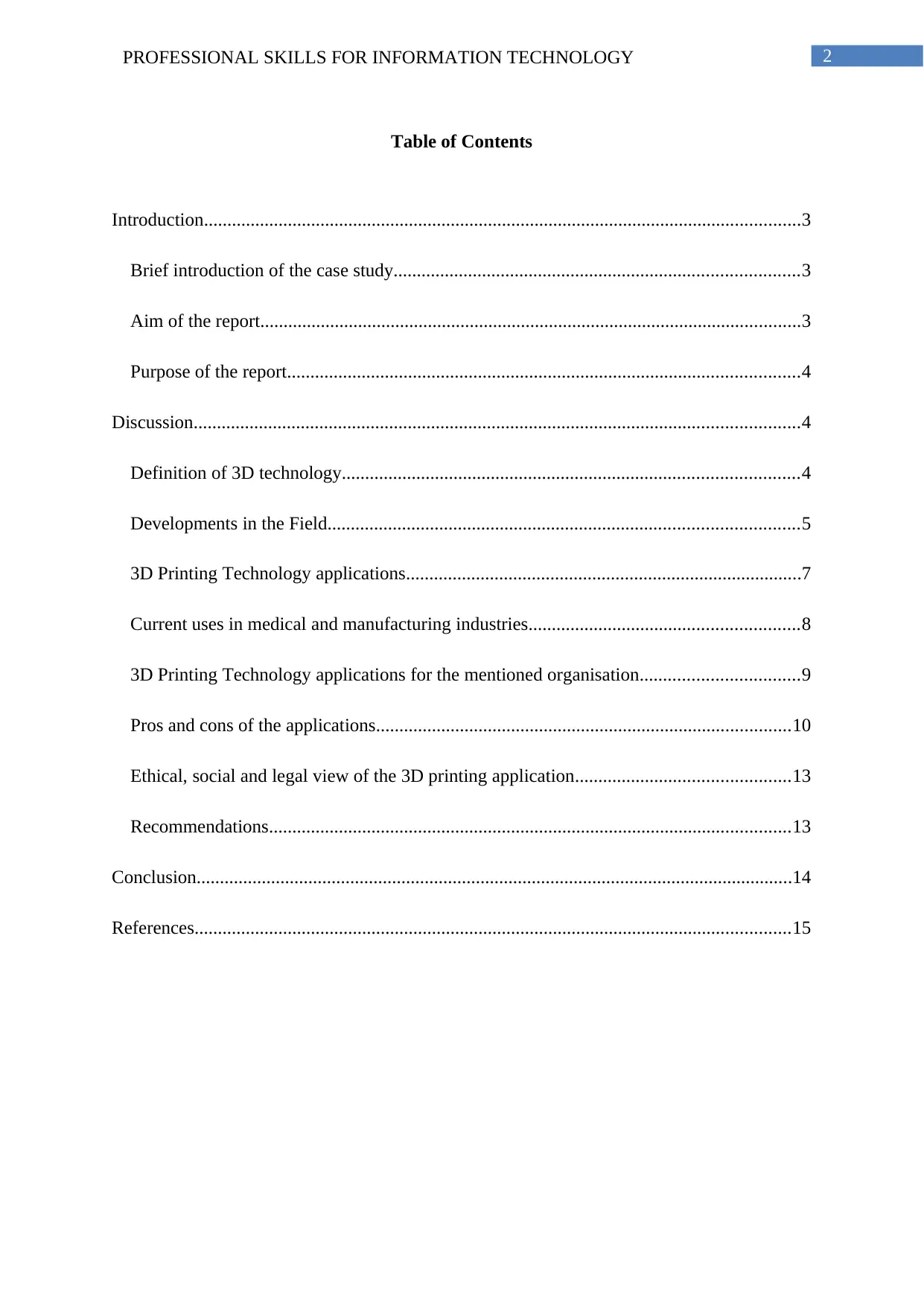
2PROFESSIONAL SKILLS FOR INFORMATION TECHNOLOGY
Table of Contents
Introduction................................................................................................................................3
Brief introduction of the case study.......................................................................................3
Aim of the report....................................................................................................................3
Purpose of the report..............................................................................................................4
Discussion..................................................................................................................................4
Definition of 3D technology..................................................................................................4
Developments in the Field.....................................................................................................5
3D Printing Technology applications.....................................................................................7
Current uses in medical and manufacturing industries..........................................................8
3D Printing Technology applications for the mentioned organisation..................................9
Pros and cons of the applications.........................................................................................10
Ethical, social and legal view of the 3D printing application..............................................13
Recommendations................................................................................................................13
Conclusion................................................................................................................................14
References................................................................................................................................15
Table of Contents
Introduction................................................................................................................................3
Brief introduction of the case study.......................................................................................3
Aim of the report....................................................................................................................3
Purpose of the report..............................................................................................................4
Discussion..................................................................................................................................4
Definition of 3D technology..................................................................................................4
Developments in the Field.....................................................................................................5
3D Printing Technology applications.....................................................................................7
Current uses in medical and manufacturing industries..........................................................8
3D Printing Technology applications for the mentioned organisation..................................9
Pros and cons of the applications.........................................................................................10
Ethical, social and legal view of the 3D printing application..............................................13
Recommendations................................................................................................................13
Conclusion................................................................................................................................14
References................................................................................................................................15
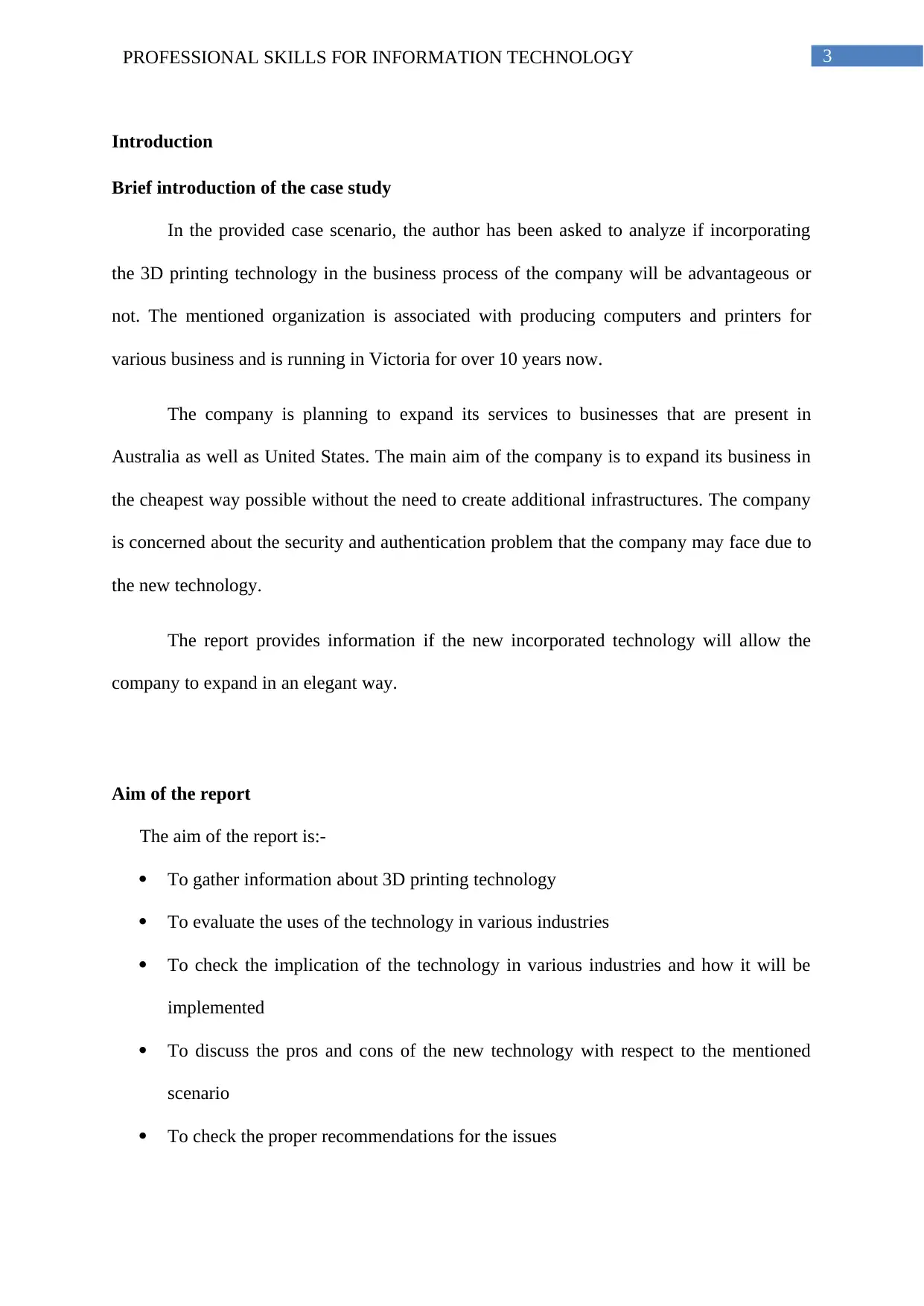
3PROFESSIONAL SKILLS FOR INFORMATION TECHNOLOGY
Introduction
Brief introduction of the case study
In the provided case scenario, the author has been asked to analyze if incorporating
the 3D printing technology in the business process of the company will be advantageous or
not. The mentioned organization is associated with producing computers and printers for
various business and is running in Victoria for over 10 years now.
The company is planning to expand its services to businesses that are present in
Australia as well as United States. The main aim of the company is to expand its business in
the cheapest way possible without the need to create additional infrastructures. The company
is concerned about the security and authentication problem that the company may face due to
the new technology.
The report provides information if the new incorporated technology will allow the
company to expand in an elegant way.
Aim of the report
The aim of the report is:-
To gather information about 3D printing technology
To evaluate the uses of the technology in various industries
To check the implication of the technology in various industries and how it will be
implemented
To discuss the pros and cons of the new technology with respect to the mentioned
scenario
To check the proper recommendations for the issues
Introduction
Brief introduction of the case study
In the provided case scenario, the author has been asked to analyze if incorporating
the 3D printing technology in the business process of the company will be advantageous or
not. The mentioned organization is associated with producing computers and printers for
various business and is running in Victoria for over 10 years now.
The company is planning to expand its services to businesses that are present in
Australia as well as United States. The main aim of the company is to expand its business in
the cheapest way possible without the need to create additional infrastructures. The company
is concerned about the security and authentication problem that the company may face due to
the new technology.
The report provides information if the new incorporated technology will allow the
company to expand in an elegant way.
Aim of the report
The aim of the report is:-
To gather information about 3D printing technology
To evaluate the uses of the technology in various industries
To check the implication of the technology in various industries and how it will be
implemented
To discuss the pros and cons of the new technology with respect to the mentioned
scenario
To check the proper recommendations for the issues
Secure Best Marks with AI Grader
Need help grading? Try our AI Grader for instant feedback on your assignments.
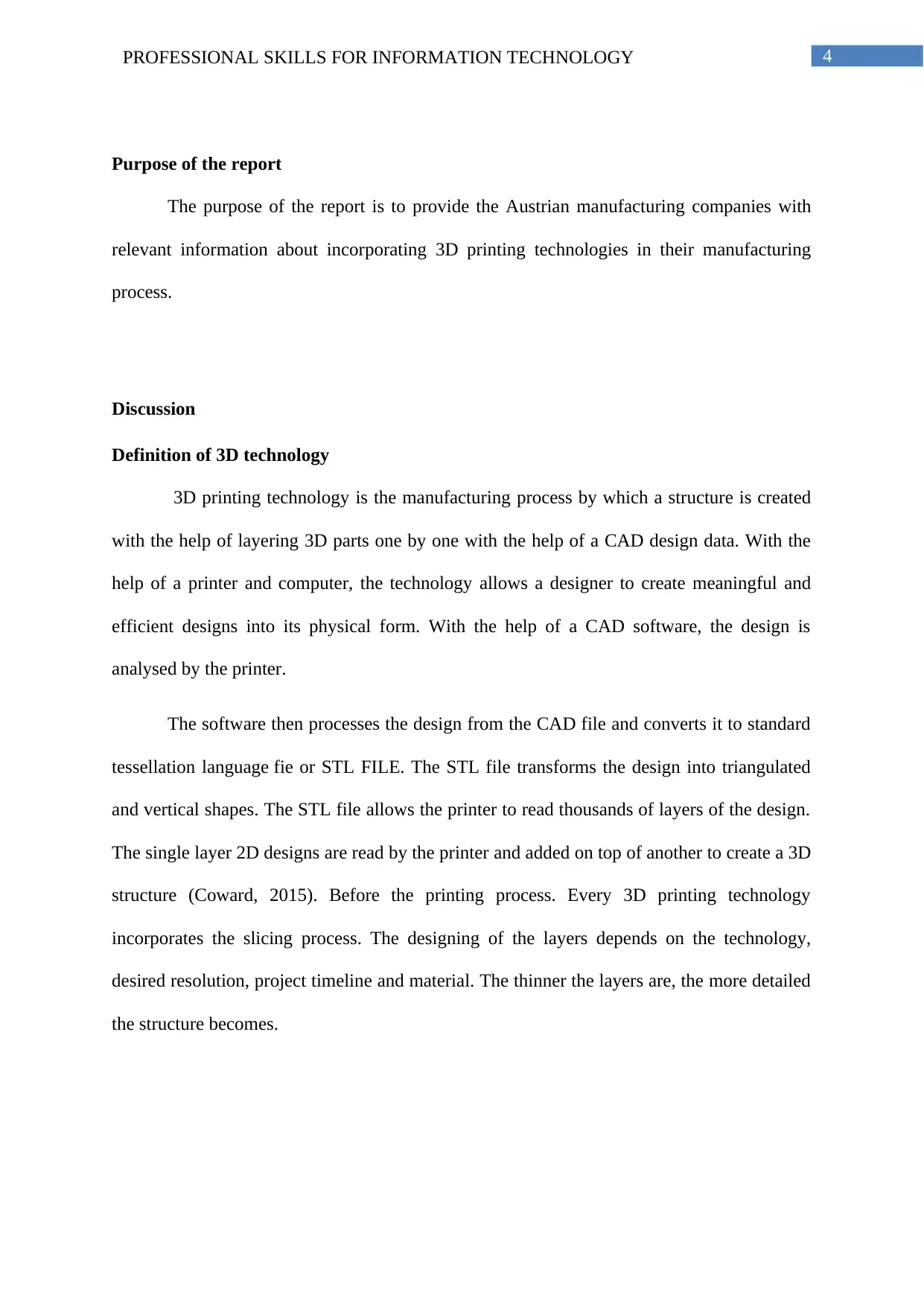
4PROFESSIONAL SKILLS FOR INFORMATION TECHNOLOGY
Purpose of the report
The purpose of the report is to provide the Austrian manufacturing companies with
relevant information about incorporating 3D printing technologies in their manufacturing
process.
Discussion
Definition of 3D technology
3D printing technology is the manufacturing process by which a structure is created
with the help of layering 3D parts one by one with the help of a CAD design data. With the
help of a printer and computer, the technology allows a designer to create meaningful and
efficient designs into its physical form. With the help of a CAD software, the design is
analysed by the printer.
The software then processes the design from the CAD file and converts it to standard
tessellation language fie or STL FILE. The STL file transforms the design into triangulated
and vertical shapes. The STL file allows the printer to read thousands of layers of the design.
The single layer 2D designs are read by the printer and added on top of another to create a 3D
structure (Coward, 2015). Before the printing process. Every 3D printing technology
incorporates the slicing process. The designing of the layers depends on the technology,
desired resolution, project timeline and material. The thinner the layers are, the more detailed
the structure becomes.
Purpose of the report
The purpose of the report is to provide the Austrian manufacturing companies with
relevant information about incorporating 3D printing technologies in their manufacturing
process.
Discussion
Definition of 3D technology
3D printing technology is the manufacturing process by which a structure is created
with the help of layering 3D parts one by one with the help of a CAD design data. With the
help of a printer and computer, the technology allows a designer to create meaningful and
efficient designs into its physical form. With the help of a CAD software, the design is
analysed by the printer.
The software then processes the design from the CAD file and converts it to standard
tessellation language fie or STL FILE. The STL file transforms the design into triangulated
and vertical shapes. The STL file allows the printer to read thousands of layers of the design.
The single layer 2D designs are read by the printer and added on top of another to create a 3D
structure (Coward, 2015). Before the printing process. Every 3D printing technology
incorporates the slicing process. The designing of the layers depends on the technology,
desired resolution, project timeline and material. The thinner the layers are, the more detailed
the structure becomes.
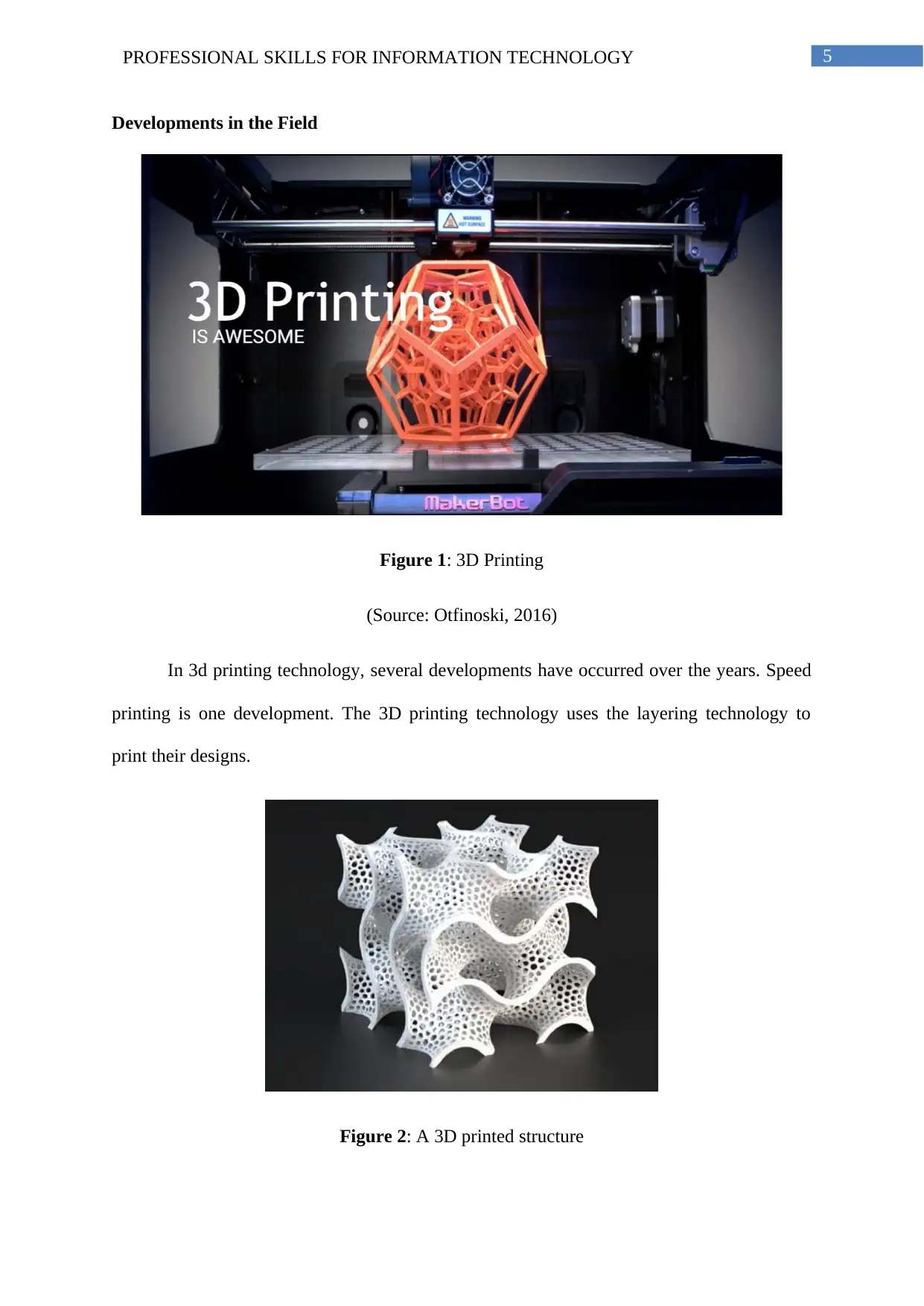
5PROFESSIONAL SKILLS FOR INFORMATION TECHNOLOGY
Developments in the Field
Figure 1: 3D Printing
(Source: Otfinoski, 2016)
In 3d printing technology, several developments have occurred over the years. Speed
printing is one development. The 3D printing technology uses the layering technology to
print their designs.
Figure 2: A 3D printed structure
Developments in the Field
Figure 1: 3D Printing
(Source: Otfinoski, 2016)
In 3d printing technology, several developments have occurred over the years. Speed
printing is one development. The 3D printing technology uses the layering technology to
print their designs.
Figure 2: A 3D printed structure
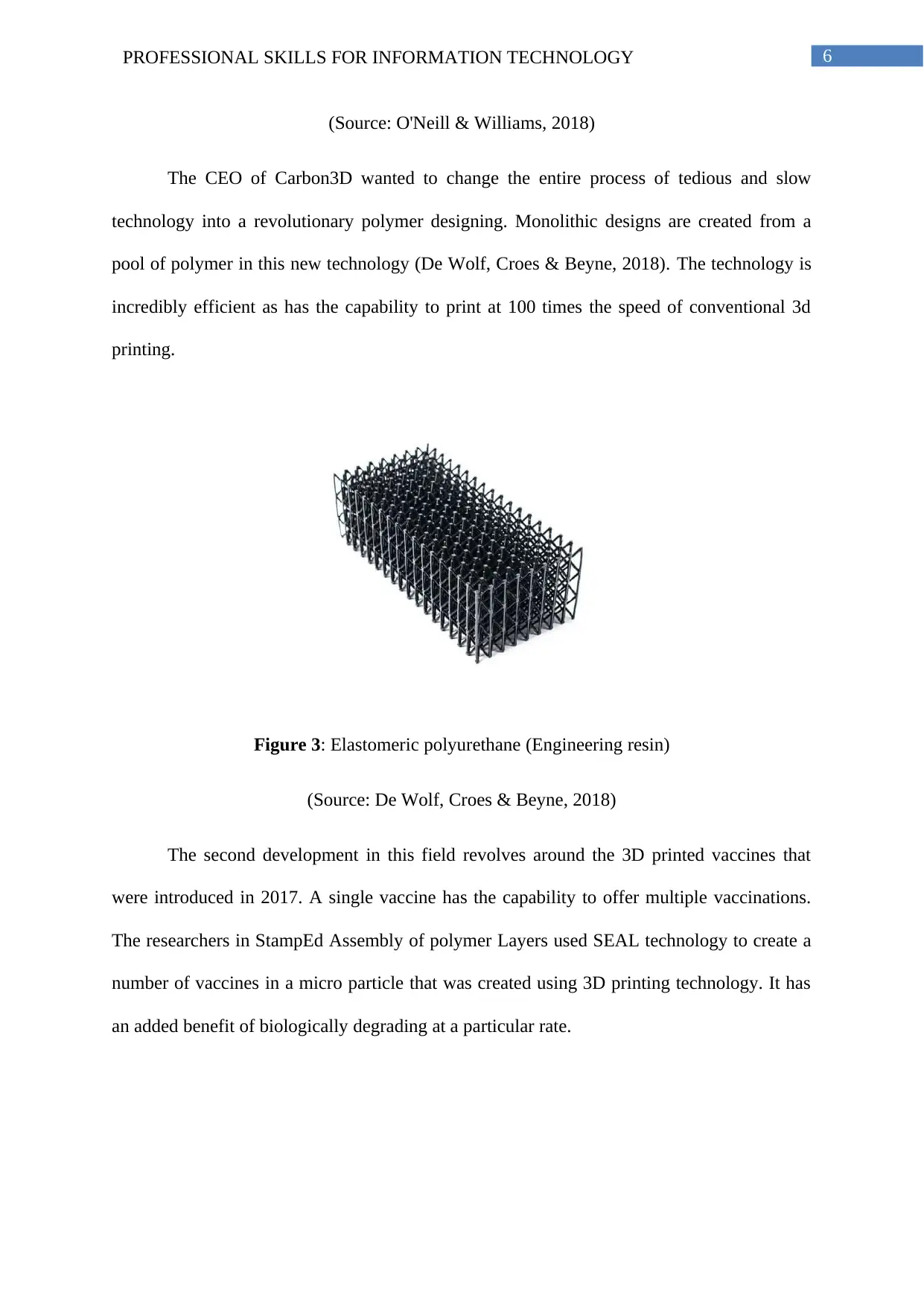
6PROFESSIONAL SKILLS FOR INFORMATION TECHNOLOGY
(Source: O'Neill & Williams, 2018)
The CEO of Carbon3D wanted to change the entire process of tedious and slow
technology into a revolutionary polymer designing. Monolithic designs are created from a
pool of polymer in this new technology (De Wolf, Croes & Beyne, 2018). The technology is
incredibly efficient as has the capability to print at 100 times the speed of conventional 3d
printing.
Figure 3: Elastomeric polyurethane (Engineering resin)
(Source: De Wolf, Croes & Beyne, 2018)
The second development in this field revolves around the 3D printed vaccines that
were introduced in 2017. A single vaccine has the capability to offer multiple vaccinations.
The researchers in StampEd Assembly of polymer Layers used SEAL technology to create a
number of vaccines in a micro particle that was created using 3D printing technology. It has
an added benefit of biologically degrading at a particular rate.
(Source: O'Neill & Williams, 2018)
The CEO of Carbon3D wanted to change the entire process of tedious and slow
technology into a revolutionary polymer designing. Monolithic designs are created from a
pool of polymer in this new technology (De Wolf, Croes & Beyne, 2018). The technology is
incredibly efficient as has the capability to print at 100 times the speed of conventional 3d
printing.
Figure 3: Elastomeric polyurethane (Engineering resin)
(Source: De Wolf, Croes & Beyne, 2018)
The second development in this field revolves around the 3D printed vaccines that
were introduced in 2017. A single vaccine has the capability to offer multiple vaccinations.
The researchers in StampEd Assembly of polymer Layers used SEAL technology to create a
number of vaccines in a micro particle that was created using 3D printing technology. It has
an added benefit of biologically degrading at a particular rate.
Paraphrase This Document
Need a fresh take? Get an instant paraphrase of this document with our AI Paraphraser
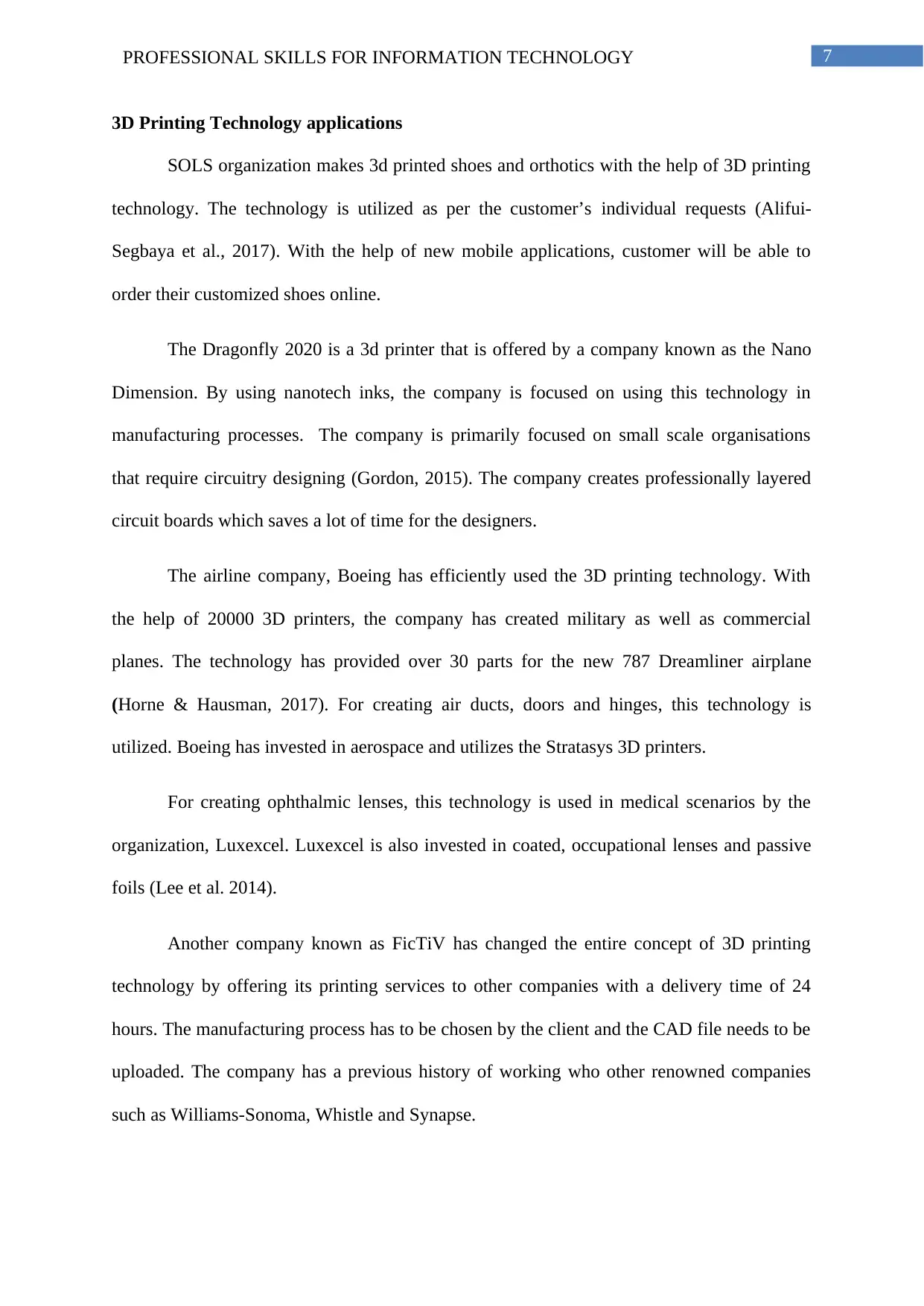
7PROFESSIONAL SKILLS FOR INFORMATION TECHNOLOGY
3D Printing Technology applications
SOLS organization makes 3d printed shoes and orthotics with the help of 3D printing
technology. The technology is utilized as per the customer’s individual requests (Alifui-
Segbaya et al., 2017). With the help of new mobile applications, customer will be able to
order their customized shoes online.
The Dragonfly 2020 is a 3d printer that is offered by a company known as the Nano
Dimension. By using nanotech inks, the company is focused on using this technology in
manufacturing processes. The company is primarily focused on small scale organisations
that require circuitry designing (Gordon, 2015). The company creates professionally layered
circuit boards which saves a lot of time for the designers.
The airline company, Boeing has efficiently used the 3D printing technology. With
the help of 20000 3D printers, the company has created military as well as commercial
planes. The technology has provided over 30 parts for the new 787 Dreamliner airplane
(Horne & Hausman, 2017). For creating air ducts, doors and hinges, this technology is
utilized. Boeing has invested in aerospace and utilizes the Stratasys 3D printers.
For creating ophthalmic lenses, this technology is used in medical scenarios by the
organization, Luxexcel. Luxexcel is also invested in coated, occupational lenses and passive
foils (Lee et al. 2014).
Another company known as FicTiV has changed the entire concept of 3D printing
technology by offering its printing services to other companies with a delivery time of 24
hours. The manufacturing process has to be chosen by the client and the CAD file needs to be
uploaded. The company has a previous history of working who other renowned companies
such as Williams-Sonoma, Whistle and Synapse.
3D Printing Technology applications
SOLS organization makes 3d printed shoes and orthotics with the help of 3D printing
technology. The technology is utilized as per the customer’s individual requests (Alifui-
Segbaya et al., 2017). With the help of new mobile applications, customer will be able to
order their customized shoes online.
The Dragonfly 2020 is a 3d printer that is offered by a company known as the Nano
Dimension. By using nanotech inks, the company is focused on using this technology in
manufacturing processes. The company is primarily focused on small scale organisations
that require circuitry designing (Gordon, 2015). The company creates professionally layered
circuit boards which saves a lot of time for the designers.
The airline company, Boeing has efficiently used the 3D printing technology. With
the help of 20000 3D printers, the company has created military as well as commercial
planes. The technology has provided over 30 parts for the new 787 Dreamliner airplane
(Horne & Hausman, 2017). For creating air ducts, doors and hinges, this technology is
utilized. Boeing has invested in aerospace and utilizes the Stratasys 3D printers.
For creating ophthalmic lenses, this technology is used in medical scenarios by the
organization, Luxexcel. Luxexcel is also invested in coated, occupational lenses and passive
foils (Lee et al. 2014).
Another company known as FicTiV has changed the entire concept of 3D printing
technology by offering its printing services to other companies with a delivery time of 24
hours. The manufacturing process has to be chosen by the client and the CAD file needs to be
uploaded. The company has a previous history of working who other renowned companies
such as Williams-Sonoma, Whistle and Synapse.

8PROFESSIONAL SKILLS FOR INFORMATION TECHNOLOGY
Current uses in medical and manufacturing industries
The use of 3D printing technology in the manufacturing process of companies is
extensive. With the help of 3D sand printer, it is used to make casting moulds in
transportation businesses. It takes normally more than six months to make a single mould but
with the help of the new technology the same mould can be created in less than a week. Fir
developmental purpose, it is used to make prototypes.
The cost of making turbine blades with the help of 3D technology can cut down its
cost of manufacturing by 50% (Coward, 2015). With the help of 3d printing, the
manufacturing industries can make heat exchangers, housing compressor with temperature
sensor, ATP engines and Dishwater components.
Figure 4: Usage of 3D technology for medical applications
(Source: Lipson, 2014)
3d printing technology has been used in medical industries to make printed bone
structures. The technology has been used immensely in prosthetics, hearing aids and foetuses.
In the future, the technology can be used to facilitate stem cell research.
Current uses in medical and manufacturing industries
The use of 3D printing technology in the manufacturing process of companies is
extensive. With the help of 3D sand printer, it is used to make casting moulds in
transportation businesses. It takes normally more than six months to make a single mould but
with the help of the new technology the same mould can be created in less than a week. Fir
developmental purpose, it is used to make prototypes.
The cost of making turbine blades with the help of 3D technology can cut down its
cost of manufacturing by 50% (Coward, 2015). With the help of 3d printing, the
manufacturing industries can make heat exchangers, housing compressor with temperature
sensor, ATP engines and Dishwater components.
Figure 4: Usage of 3D technology for medical applications
(Source: Lipson, 2014)
3d printing technology has been used in medical industries to make printed bone
structures. The technology has been used immensely in prosthetics, hearing aids and foetuses.
In the future, the technology can be used to facilitate stem cell research.
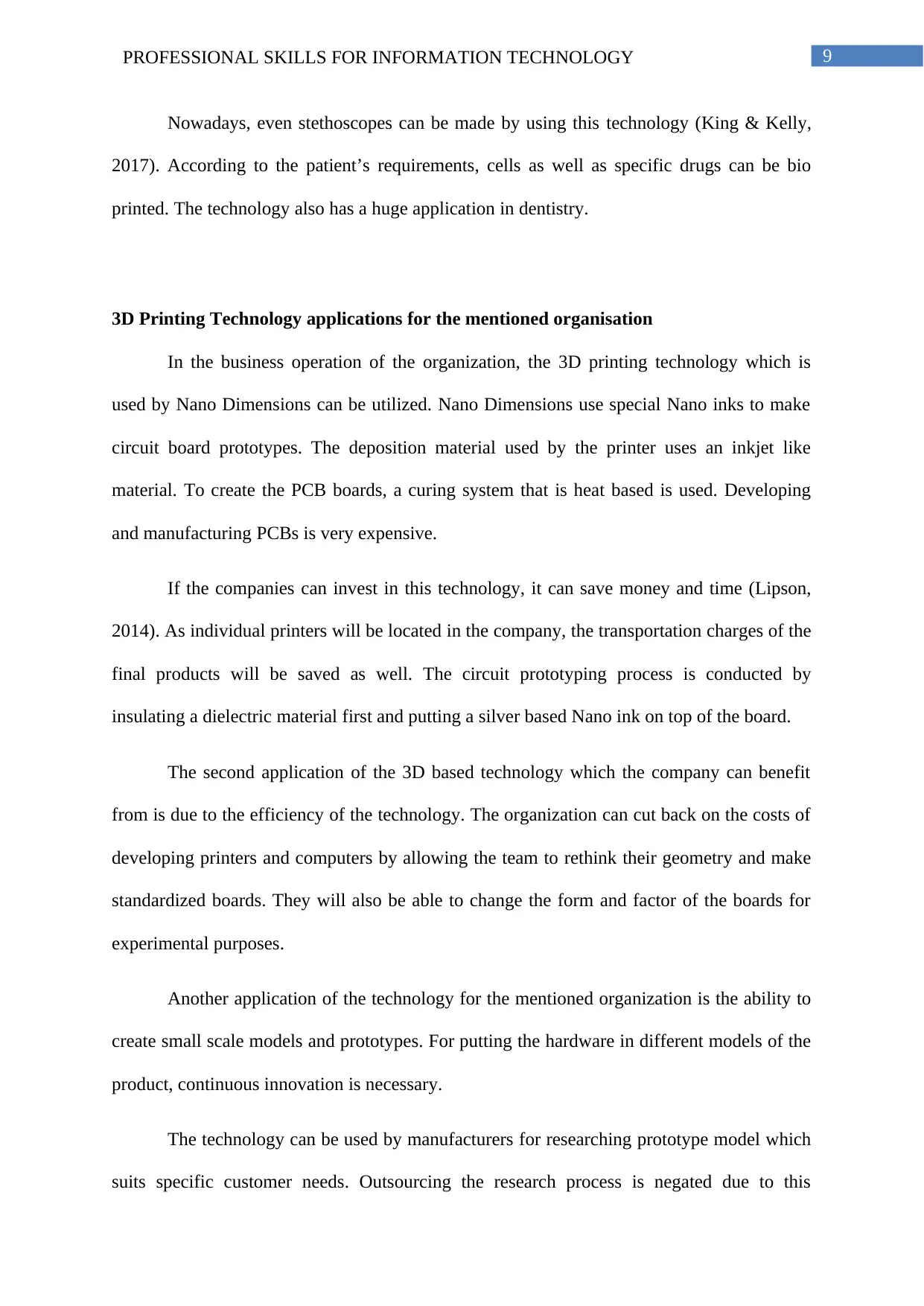
9PROFESSIONAL SKILLS FOR INFORMATION TECHNOLOGY
Nowadays, even stethoscopes can be made by using this technology (King & Kelly,
2017). According to the patient’s requirements, cells as well as specific drugs can be bio
printed. The technology also has a huge application in dentistry.
3D Printing Technology applications for the mentioned organisation
In the business operation of the organization, the 3D printing technology which is
used by Nano Dimensions can be utilized. Nano Dimensions use special Nano inks to make
circuit board prototypes. The deposition material used by the printer uses an inkjet like
material. To create the PCB boards, a curing system that is heat based is used. Developing
and manufacturing PCBs is very expensive.
If the companies can invest in this technology, it can save money and time (Lipson,
2014). As individual printers will be located in the company, the transportation charges of the
final products will be saved as well. The circuit prototyping process is conducted by
insulating a dielectric material first and putting a silver based Nano ink on top of the board.
The second application of the 3D based technology which the company can benefit
from is due to the efficiency of the technology. The organization can cut back on the costs of
developing printers and computers by allowing the team to rethink their geometry and make
standardized boards. They will also be able to change the form and factor of the boards for
experimental purposes.
Another application of the technology for the mentioned organization is the ability to
create small scale models and prototypes. For putting the hardware in different models of the
product, continuous innovation is necessary.
The technology can be used by manufacturers for researching prototype model which
suits specific customer needs. Outsourcing the research process is negated due to this
Nowadays, even stethoscopes can be made by using this technology (King & Kelly,
2017). According to the patient’s requirements, cells as well as specific drugs can be bio
printed. The technology also has a huge application in dentistry.
3D Printing Technology applications for the mentioned organisation
In the business operation of the organization, the 3D printing technology which is
used by Nano Dimensions can be utilized. Nano Dimensions use special Nano inks to make
circuit board prototypes. The deposition material used by the printer uses an inkjet like
material. To create the PCB boards, a curing system that is heat based is used. Developing
and manufacturing PCBs is very expensive.
If the companies can invest in this technology, it can save money and time (Lipson,
2014). As individual printers will be located in the company, the transportation charges of the
final products will be saved as well. The circuit prototyping process is conducted by
insulating a dielectric material first and putting a silver based Nano ink on top of the board.
The second application of the 3D based technology which the company can benefit
from is due to the efficiency of the technology. The organization can cut back on the costs of
developing printers and computers by allowing the team to rethink their geometry and make
standardized boards. They will also be able to change the form and factor of the boards for
experimental purposes.
Another application of the technology for the mentioned organization is the ability to
create small scale models and prototypes. For putting the hardware in different models of the
product, continuous innovation is necessary.
The technology can be used by manufacturers for researching prototype model which
suits specific customer needs. Outsourcing the research process is negated due to this
Secure Best Marks with AI Grader
Need help grading? Try our AI Grader for instant feedback on your assignments.
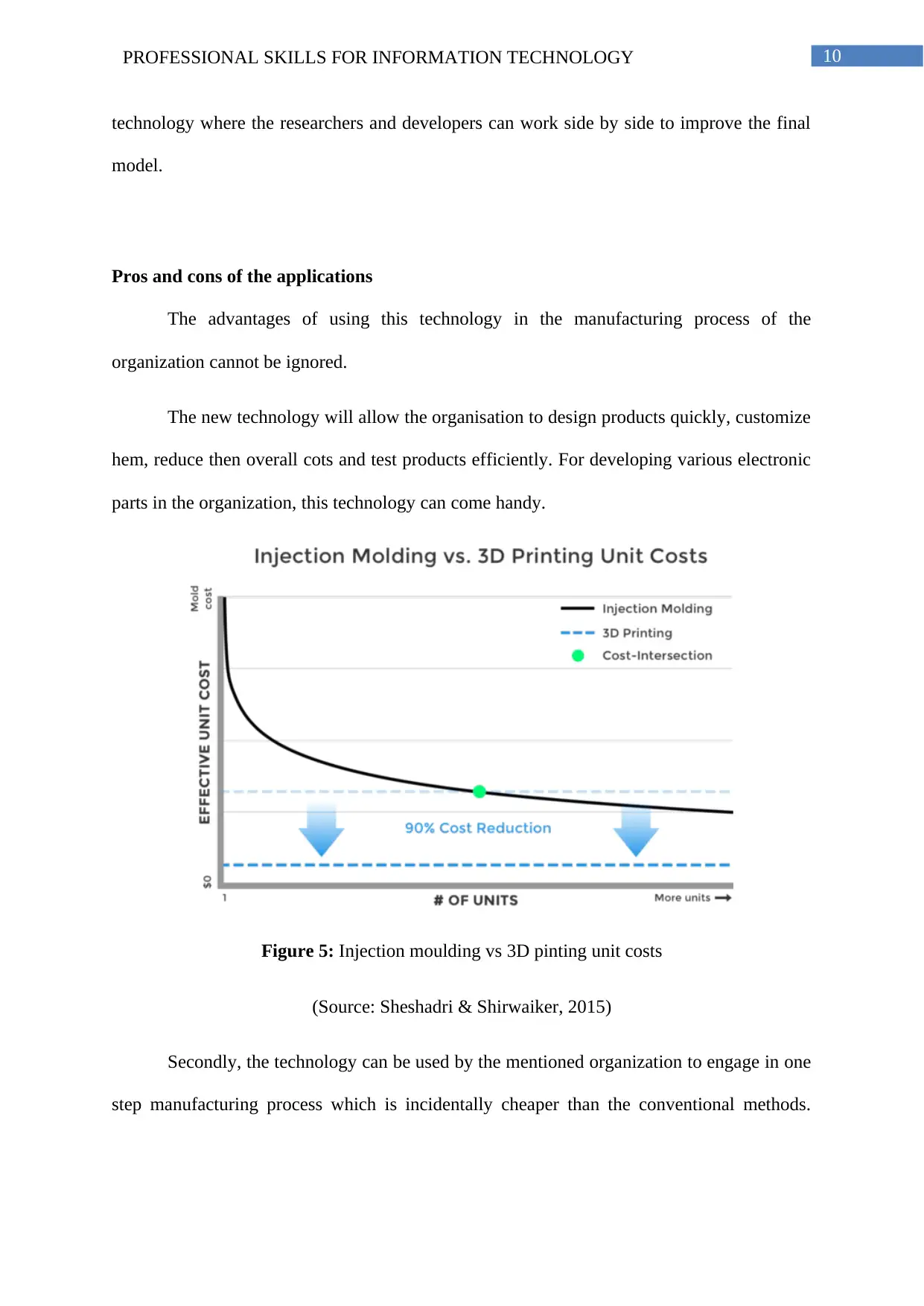
10PROFESSIONAL SKILLS FOR INFORMATION TECHNOLOGY
technology where the researchers and developers can work side by side to improve the final
model.
Pros and cons of the applications
The advantages of using this technology in the manufacturing process of the
organization cannot be ignored.
The new technology will allow the organisation to design products quickly, customize
hem, reduce then overall cots and test products efficiently. For developing various electronic
parts in the organization, this technology can come handy.
Figure 5: Injection moulding vs 3D pinting unit costs
(Source: Sheshadri & Shirwaiker, 2015)
Secondly, the technology can be used by the mentioned organization to engage in one
step manufacturing process which is incidentally cheaper than the conventional methods.
technology where the researchers and developers can work side by side to improve the final
model.
Pros and cons of the applications
The advantages of using this technology in the manufacturing process of the
organization cannot be ignored.
The new technology will allow the organisation to design products quickly, customize
hem, reduce then overall cots and test products efficiently. For developing various electronic
parts in the organization, this technology can come handy.
Figure 5: Injection moulding vs 3D pinting unit costs
(Source: Sheshadri & Shirwaiker, 2015)
Secondly, the technology can be used by the mentioned organization to engage in one
step manufacturing process which is incidentally cheaper than the conventional methods.
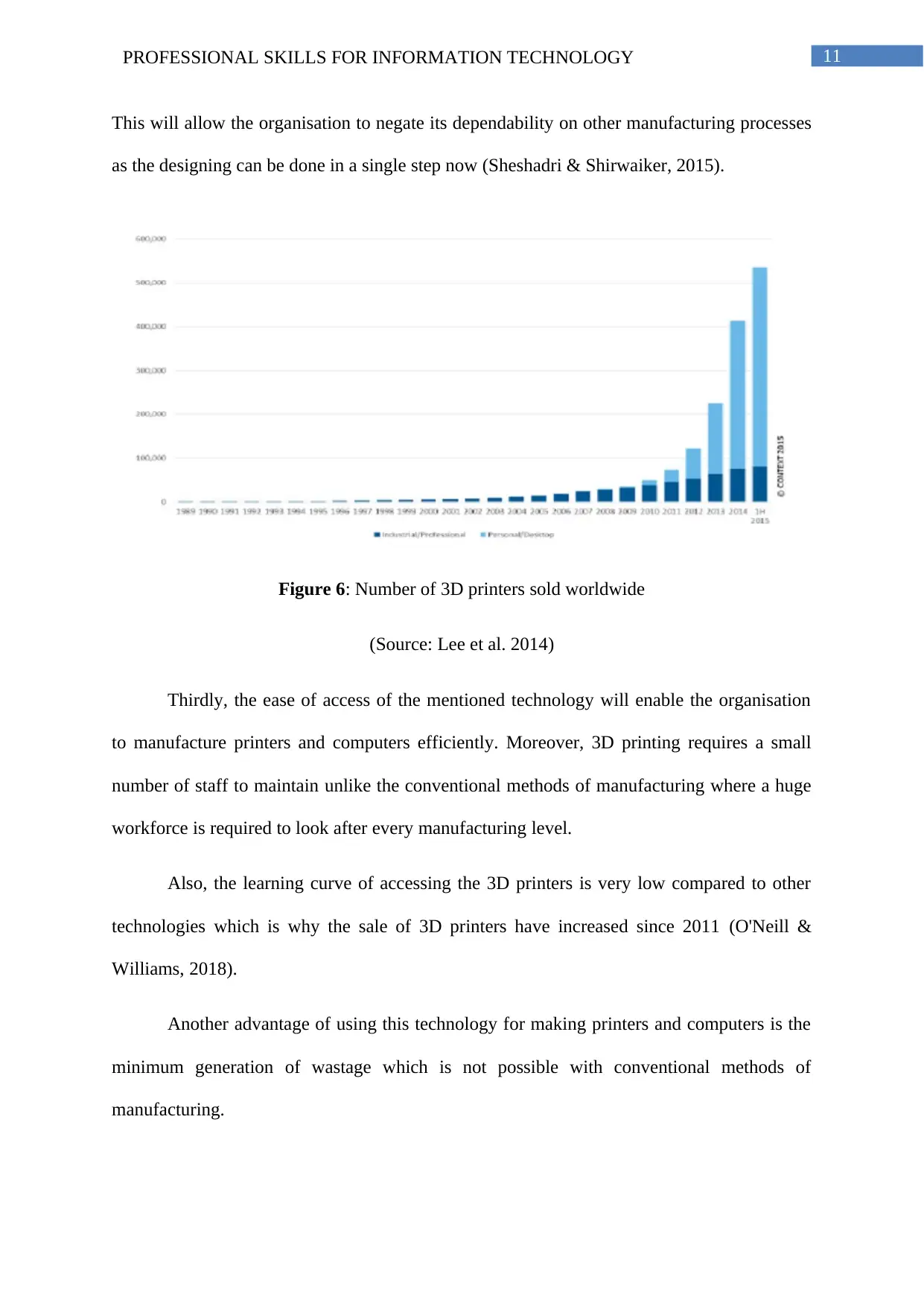
11PROFESSIONAL SKILLS FOR INFORMATION TECHNOLOGY
This will allow the organisation to negate its dependability on other manufacturing processes
as the designing can be done in a single step now (Sheshadri & Shirwaiker, 2015).
Figure 6: Number of 3D printers sold worldwide
(Source: Lee et al. 2014)
Thirdly, the ease of access of the mentioned technology will enable the organisation
to manufacture printers and computers efficiently. Moreover, 3D printing requires a small
number of staff to maintain unlike the conventional methods of manufacturing where a huge
workforce is required to look after every manufacturing level.
Also, the learning curve of accessing the 3D printers is very low compared to other
technologies which is why the sale of 3D printers have increased since 2011 (O'Neill &
Williams, 2018).
Another advantage of using this technology for making printers and computers is the
minimum generation of wastage which is not possible with conventional methods of
manufacturing.
This will allow the organisation to negate its dependability on other manufacturing processes
as the designing can be done in a single step now (Sheshadri & Shirwaiker, 2015).
Figure 6: Number of 3D printers sold worldwide
(Source: Lee et al. 2014)
Thirdly, the ease of access of the mentioned technology will enable the organisation
to manufacture printers and computers efficiently. Moreover, 3D printing requires a small
number of staff to maintain unlike the conventional methods of manufacturing where a huge
workforce is required to look after every manufacturing level.
Also, the learning curve of accessing the 3D printers is very low compared to other
technologies which is why the sale of 3D printers have increased since 2011 (O'Neill &
Williams, 2018).
Another advantage of using this technology for making printers and computers is the
minimum generation of wastage which is not possible with conventional methods of
manufacturing.
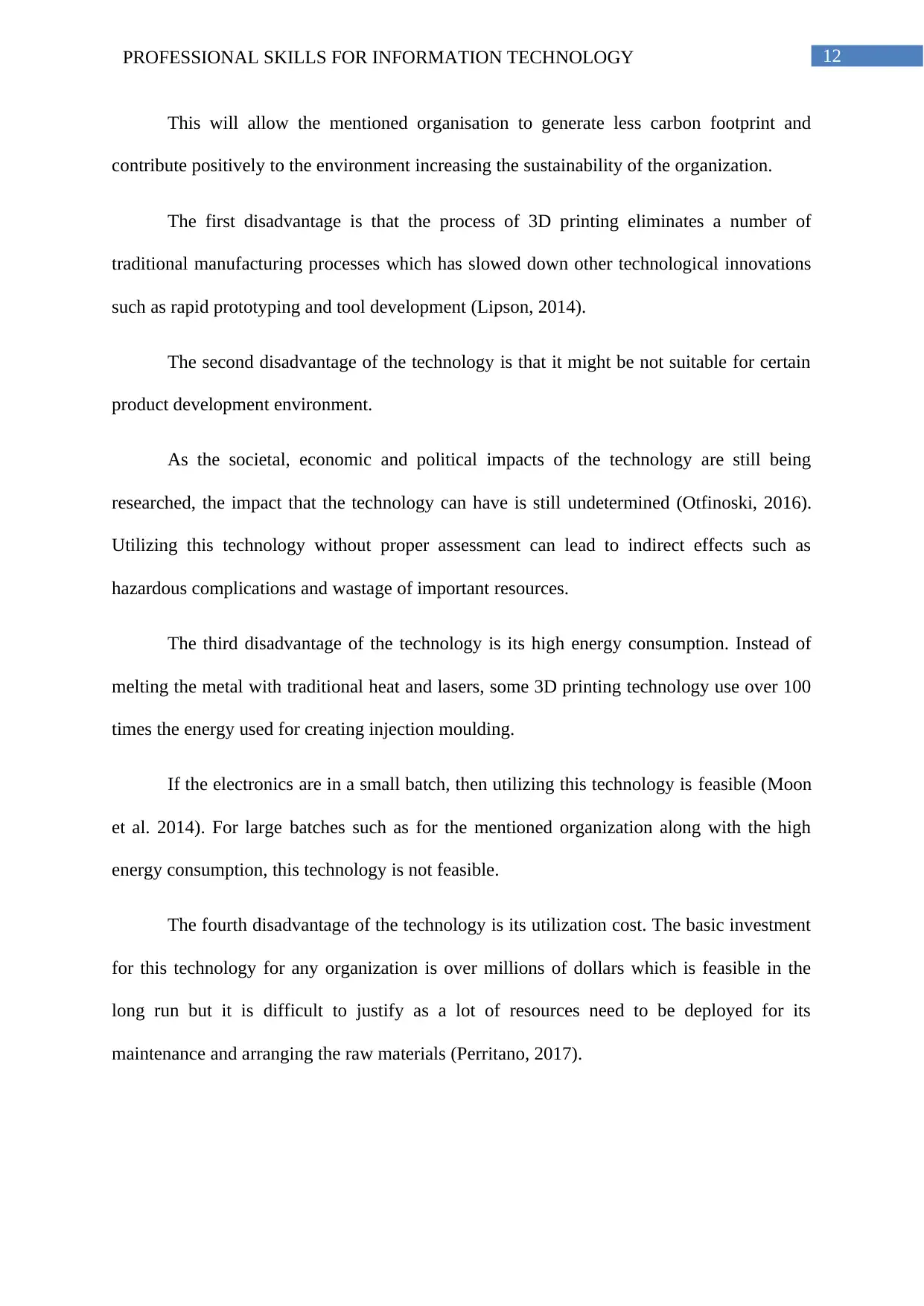
12PROFESSIONAL SKILLS FOR INFORMATION TECHNOLOGY
This will allow the mentioned organisation to generate less carbon footprint and
contribute positively to the environment increasing the sustainability of the organization.
The first disadvantage is that the process of 3D printing eliminates a number of
traditional manufacturing processes which has slowed down other technological innovations
such as rapid prototyping and tool development (Lipson, 2014).
The second disadvantage of the technology is that it might be not suitable for certain
product development environment.
As the societal, economic and political impacts of the technology are still being
researched, the impact that the technology can have is still undetermined (Otfinoski, 2016).
Utilizing this technology without proper assessment can lead to indirect effects such as
hazardous complications and wastage of important resources.
The third disadvantage of the technology is its high energy consumption. Instead of
melting the metal with traditional heat and lasers, some 3D printing technology use over 100
times the energy used for creating injection moulding.
If the electronics are in a small batch, then utilizing this technology is feasible (Moon
et al. 2014). For large batches such as for the mentioned organization along with the high
energy consumption, this technology is not feasible.
The fourth disadvantage of the technology is its utilization cost. The basic investment
for this technology for any organization is over millions of dollars which is feasible in the
long run but it is difficult to justify as a lot of resources need to be deployed for its
maintenance and arranging the raw materials (Perritano, 2017).
This will allow the mentioned organisation to generate less carbon footprint and
contribute positively to the environment increasing the sustainability of the organization.
The first disadvantage is that the process of 3D printing eliminates a number of
traditional manufacturing processes which has slowed down other technological innovations
such as rapid prototyping and tool development (Lipson, 2014).
The second disadvantage of the technology is that it might be not suitable for certain
product development environment.
As the societal, economic and political impacts of the technology are still being
researched, the impact that the technology can have is still undetermined (Otfinoski, 2016).
Utilizing this technology without proper assessment can lead to indirect effects such as
hazardous complications and wastage of important resources.
The third disadvantage of the technology is its high energy consumption. Instead of
melting the metal with traditional heat and lasers, some 3D printing technology use over 100
times the energy used for creating injection moulding.
If the electronics are in a small batch, then utilizing this technology is feasible (Moon
et al. 2014). For large batches such as for the mentioned organization along with the high
energy consumption, this technology is not feasible.
The fourth disadvantage of the technology is its utilization cost. The basic investment
for this technology for any organization is over millions of dollars which is feasible in the
long run but it is difficult to justify as a lot of resources need to be deployed for its
maintenance and arranging the raw materials (Perritano, 2017).
Paraphrase This Document
Need a fresh take? Get an instant paraphrase of this document with our AI Paraphraser

13PROFESSIONAL SKILLS FOR INFORMATION TECHNOLOGY
Ethical, social and legal view of the 3D printing application
The ethical point of 3D application in this scenario is that the funding that any project
gets for R&D purposes. The funding is generally given by a third party who rarely has a
knowledge about the project that they are funding. This raises an ethical question about how
can one judge which project needs funding over another and how it is justified which project
is more significant than the other.
The social aspect of using this technology is the loss of jobs in the manufacturing
sector. Since the 3D printing technology eliminates a lot of subtractive manufacturing
resulting in the reduction of the labor costs, it poses a huge social risk due to rise in
unemployment which can affect a huge number of people financially (Gebler, Uiterkamp &
Visser, 2014).
The legal point of view of this application is copyright infringement. As 3d printing is
done with a blueprint, it becomes increasingly difficult for the organization to check whether
they are violating any other copyright laws (O'Neill & Williams, 2018). Violation of
copyright laws can affect the manufacturing process of the company in the future.
Recommendations
The organization can use 3d printing technology as an additive technology to assist
the traditional manufacturing processes of the company. This way the social aspect of the
technology can be targeted to prevent the loss of jobs of individuals and retain the effective
manufacturing of the organization.
The second recommendation is to check effectively whether the organization is not
violating any copyright laws. In this way the legal aspect of the technology can be addressed.
Ethical, social and legal view of the 3D printing application
The ethical point of 3D application in this scenario is that the funding that any project
gets for R&D purposes. The funding is generally given by a third party who rarely has a
knowledge about the project that they are funding. This raises an ethical question about how
can one judge which project needs funding over another and how it is justified which project
is more significant than the other.
The social aspect of using this technology is the loss of jobs in the manufacturing
sector. Since the 3D printing technology eliminates a lot of subtractive manufacturing
resulting in the reduction of the labor costs, it poses a huge social risk due to rise in
unemployment which can affect a huge number of people financially (Gebler, Uiterkamp &
Visser, 2014).
The legal point of view of this application is copyright infringement. As 3d printing is
done with a blueprint, it becomes increasingly difficult for the organization to check whether
they are violating any other copyright laws (O'Neill & Williams, 2018). Violation of
copyright laws can affect the manufacturing process of the company in the future.
Recommendations
The organization can use 3d printing technology as an additive technology to assist
the traditional manufacturing processes of the company. This way the social aspect of the
technology can be targeted to prevent the loss of jobs of individuals and retain the effective
manufacturing of the organization.
The second recommendation is to check effectively whether the organization is not
violating any copyright laws. In this way the legal aspect of the technology can be addressed.
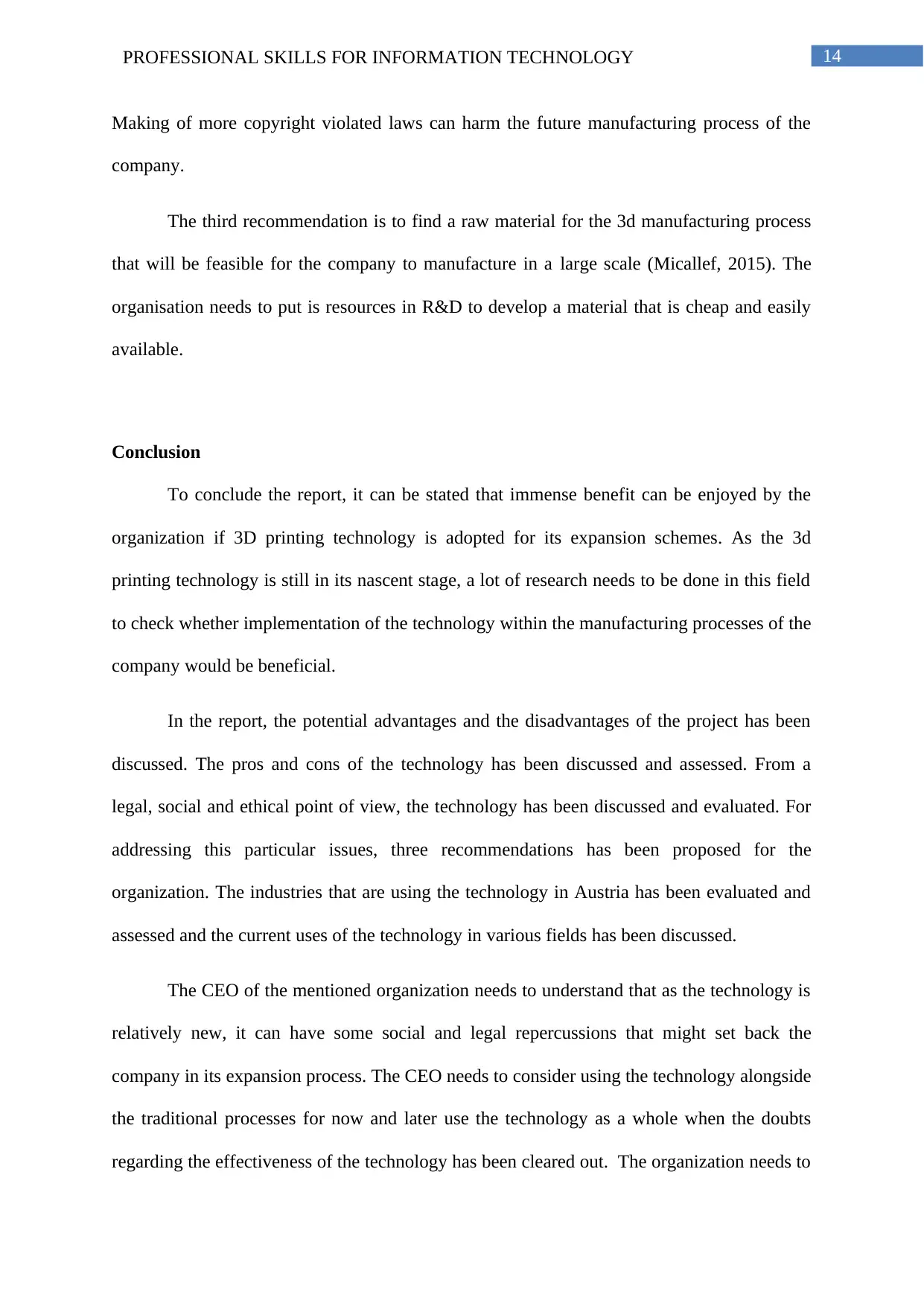
14PROFESSIONAL SKILLS FOR INFORMATION TECHNOLOGY
Making of more copyright violated laws can harm the future manufacturing process of the
company.
The third recommendation is to find a raw material for the 3d manufacturing process
that will be feasible for the company to manufacture in a large scale (Micallef, 2015). The
organisation needs to put is resources in R&D to develop a material that is cheap and easily
available.
Conclusion
To conclude the report, it can be stated that immense benefit can be enjoyed by the
organization if 3D printing technology is adopted for its expansion schemes. As the 3d
printing technology is still in its nascent stage, a lot of research needs to be done in this field
to check whether implementation of the technology within the manufacturing processes of the
company would be beneficial.
In the report, the potential advantages and the disadvantages of the project has been
discussed. The pros and cons of the technology has been discussed and assessed. From a
legal, social and ethical point of view, the technology has been discussed and evaluated. For
addressing this particular issues, three recommendations has been proposed for the
organization. The industries that are using the technology in Austria has been evaluated and
assessed and the current uses of the technology in various fields has been discussed.
The CEO of the mentioned organization needs to understand that as the technology is
relatively new, it can have some social and legal repercussions that might set back the
company in its expansion process. The CEO needs to consider using the technology alongside
the traditional processes for now and later use the technology as a whole when the doubts
regarding the effectiveness of the technology has been cleared out. The organization needs to
Making of more copyright violated laws can harm the future manufacturing process of the
company.
The third recommendation is to find a raw material for the 3d manufacturing process
that will be feasible for the company to manufacture in a large scale (Micallef, 2015). The
organisation needs to put is resources in R&D to develop a material that is cheap and easily
available.
Conclusion
To conclude the report, it can be stated that immense benefit can be enjoyed by the
organization if 3D printing technology is adopted for its expansion schemes. As the 3d
printing technology is still in its nascent stage, a lot of research needs to be done in this field
to check whether implementation of the technology within the manufacturing processes of the
company would be beneficial.
In the report, the potential advantages and the disadvantages of the project has been
discussed. The pros and cons of the technology has been discussed and assessed. From a
legal, social and ethical point of view, the technology has been discussed and evaluated. For
addressing this particular issues, three recommendations has been proposed for the
organization. The industries that are using the technology in Austria has been evaluated and
assessed and the current uses of the technology in various fields has been discussed.
The CEO of the mentioned organization needs to understand that as the technology is
relatively new, it can have some social and legal repercussions that might set back the
company in its expansion process. The CEO needs to consider using the technology alongside
the traditional processes for now and later use the technology as a whole when the doubts
regarding the effectiveness of the technology has been cleared out. The organization needs to
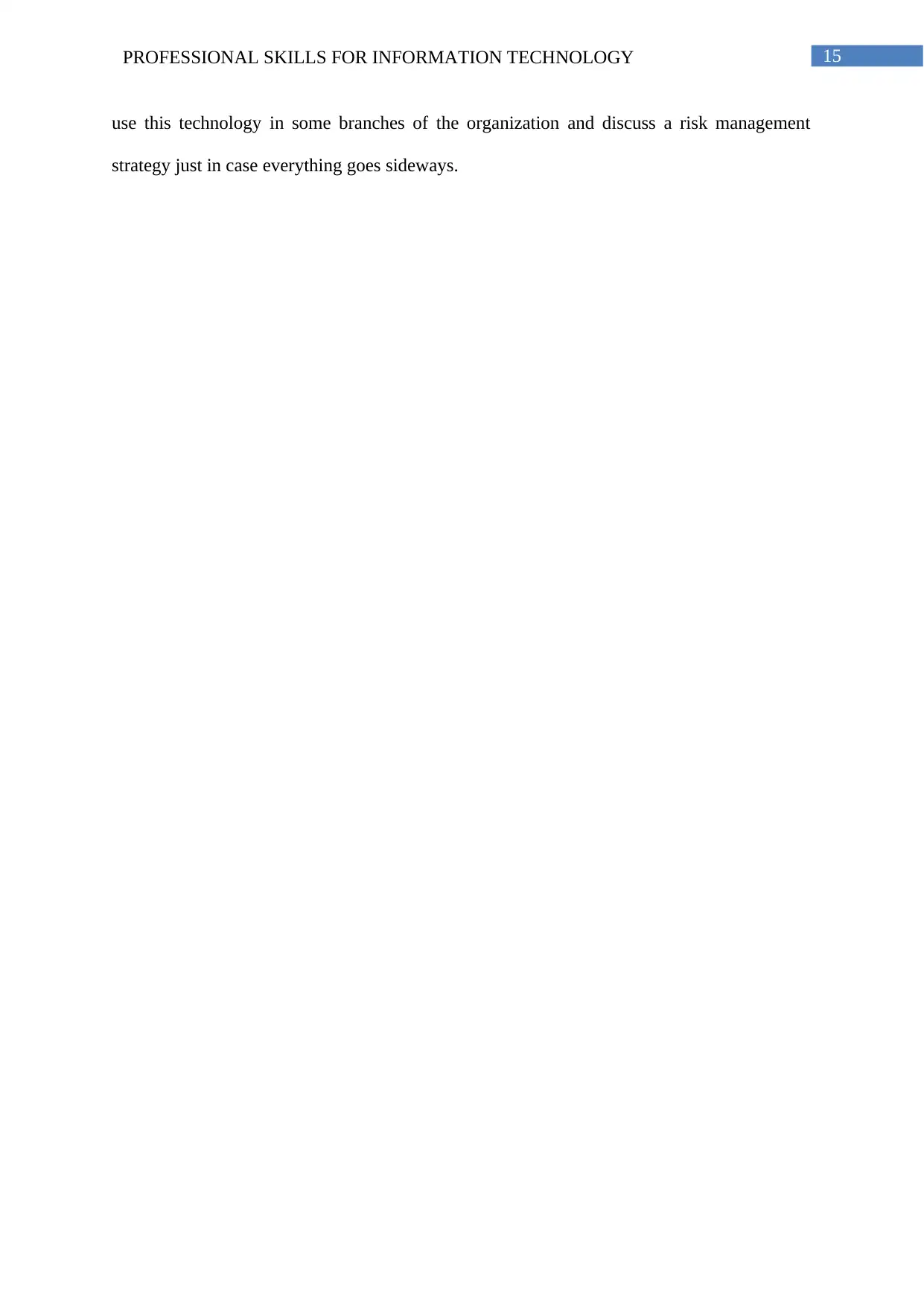
15PROFESSIONAL SKILLS FOR INFORMATION TECHNOLOGY
use this technology in some branches of the organization and discuss a risk management
strategy just in case everything goes sideways.
use this technology in some branches of the organization and discuss a risk management
strategy just in case everything goes sideways.
Secure Best Marks with AI Grader
Need help grading? Try our AI Grader for instant feedback on your assignments.
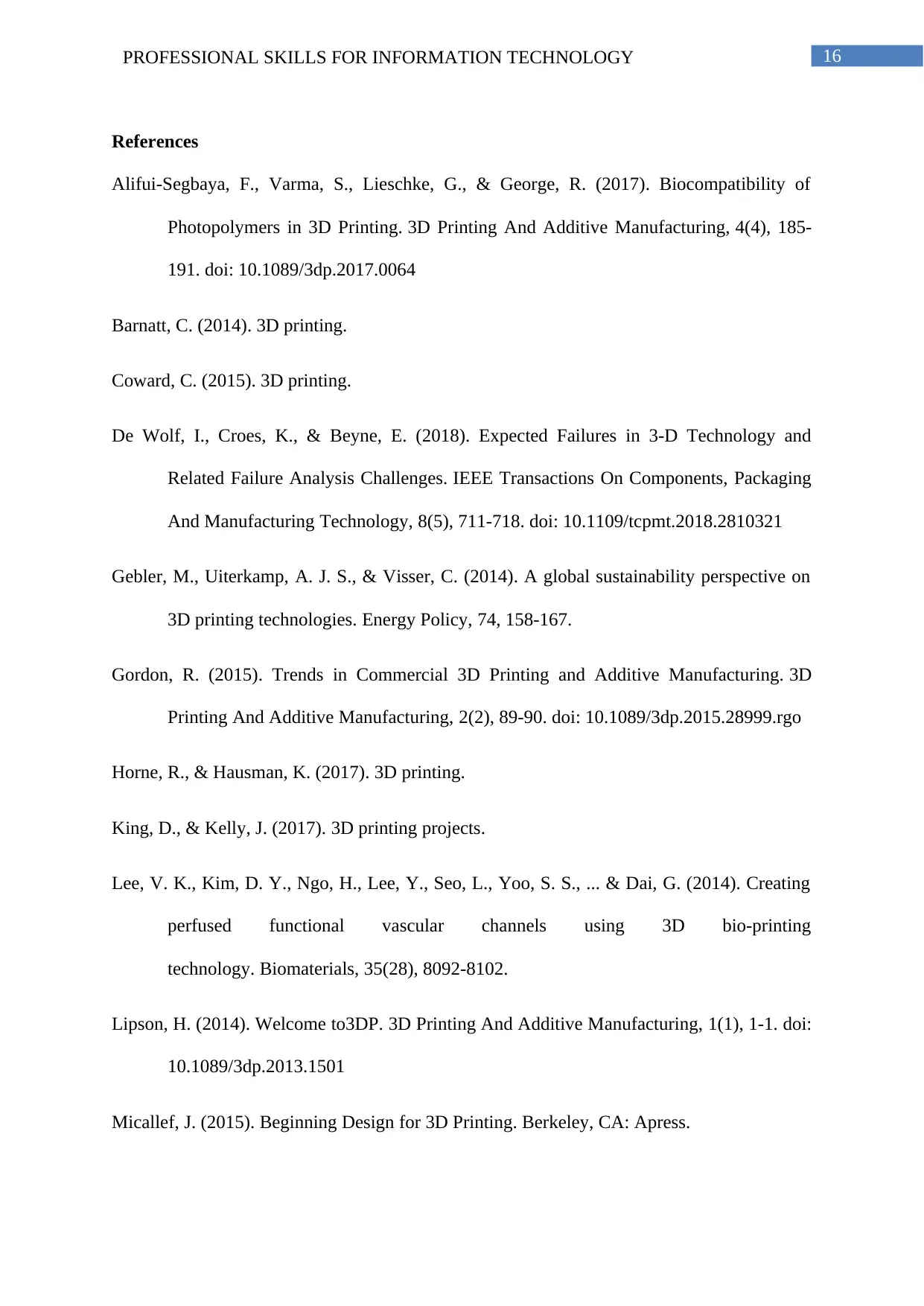
16PROFESSIONAL SKILLS FOR INFORMATION TECHNOLOGY
References
Alifui-Segbaya, F., Varma, S., Lieschke, G., & George, R. (2017). Biocompatibility of
Photopolymers in 3D Printing. 3D Printing And Additive Manufacturing, 4(4), 185-
191. doi: 10.1089/3dp.2017.0064
Barnatt, C. (2014). 3D printing.
Coward, C. (2015). 3D printing.
De Wolf, I., Croes, K., & Beyne, E. (2018). Expected Failures in 3-D Technology and
Related Failure Analysis Challenges. IEEE Transactions On Components, Packaging
And Manufacturing Technology, 8(5), 711-718. doi: 10.1109/tcpmt.2018.2810321
Gebler, M., Uiterkamp, A. J. S., & Visser, C. (2014). A global sustainability perspective on
3D printing technologies. Energy Policy, 74, 158-167.
Gordon, R. (2015). Trends in Commercial 3D Printing and Additive Manufacturing. 3D
Printing And Additive Manufacturing, 2(2), 89-90. doi: 10.1089/3dp.2015.28999.rgo
Horne, R., & Hausman, K. (2017). 3D printing.
King, D., & Kelly, J. (2017). 3D printing projects.
Lee, V. K., Kim, D. Y., Ngo, H., Lee, Y., Seo, L., Yoo, S. S., ... & Dai, G. (2014). Creating
perfused functional vascular channels using 3D bio-printing
technology. Biomaterials, 35(28), 8092-8102.
Lipson, H. (2014). Welcome to3DP. 3D Printing And Additive Manufacturing, 1(1), 1-1. doi:
10.1089/3dp.2013.1501
Micallef, J. (2015). Beginning Design for 3D Printing. Berkeley, CA: Apress.
References
Alifui-Segbaya, F., Varma, S., Lieschke, G., & George, R. (2017). Biocompatibility of
Photopolymers in 3D Printing. 3D Printing And Additive Manufacturing, 4(4), 185-
191. doi: 10.1089/3dp.2017.0064
Barnatt, C. (2014). 3D printing.
Coward, C. (2015). 3D printing.
De Wolf, I., Croes, K., & Beyne, E. (2018). Expected Failures in 3-D Technology and
Related Failure Analysis Challenges. IEEE Transactions On Components, Packaging
And Manufacturing Technology, 8(5), 711-718. doi: 10.1109/tcpmt.2018.2810321
Gebler, M., Uiterkamp, A. J. S., & Visser, C. (2014). A global sustainability perspective on
3D printing technologies. Energy Policy, 74, 158-167.
Gordon, R. (2015). Trends in Commercial 3D Printing and Additive Manufacturing. 3D
Printing And Additive Manufacturing, 2(2), 89-90. doi: 10.1089/3dp.2015.28999.rgo
Horne, R., & Hausman, K. (2017). 3D printing.
King, D., & Kelly, J. (2017). 3D printing projects.
Lee, V. K., Kim, D. Y., Ngo, H., Lee, Y., Seo, L., Yoo, S. S., ... & Dai, G. (2014). Creating
perfused functional vascular channels using 3D bio-printing
technology. Biomaterials, 35(28), 8092-8102.
Lipson, H. (2014). Welcome to3DP. 3D Printing And Additive Manufacturing, 1(1), 1-1. doi:
10.1089/3dp.2013.1501
Micallef, J. (2015). Beginning Design for 3D Printing. Berkeley, CA: Apress.
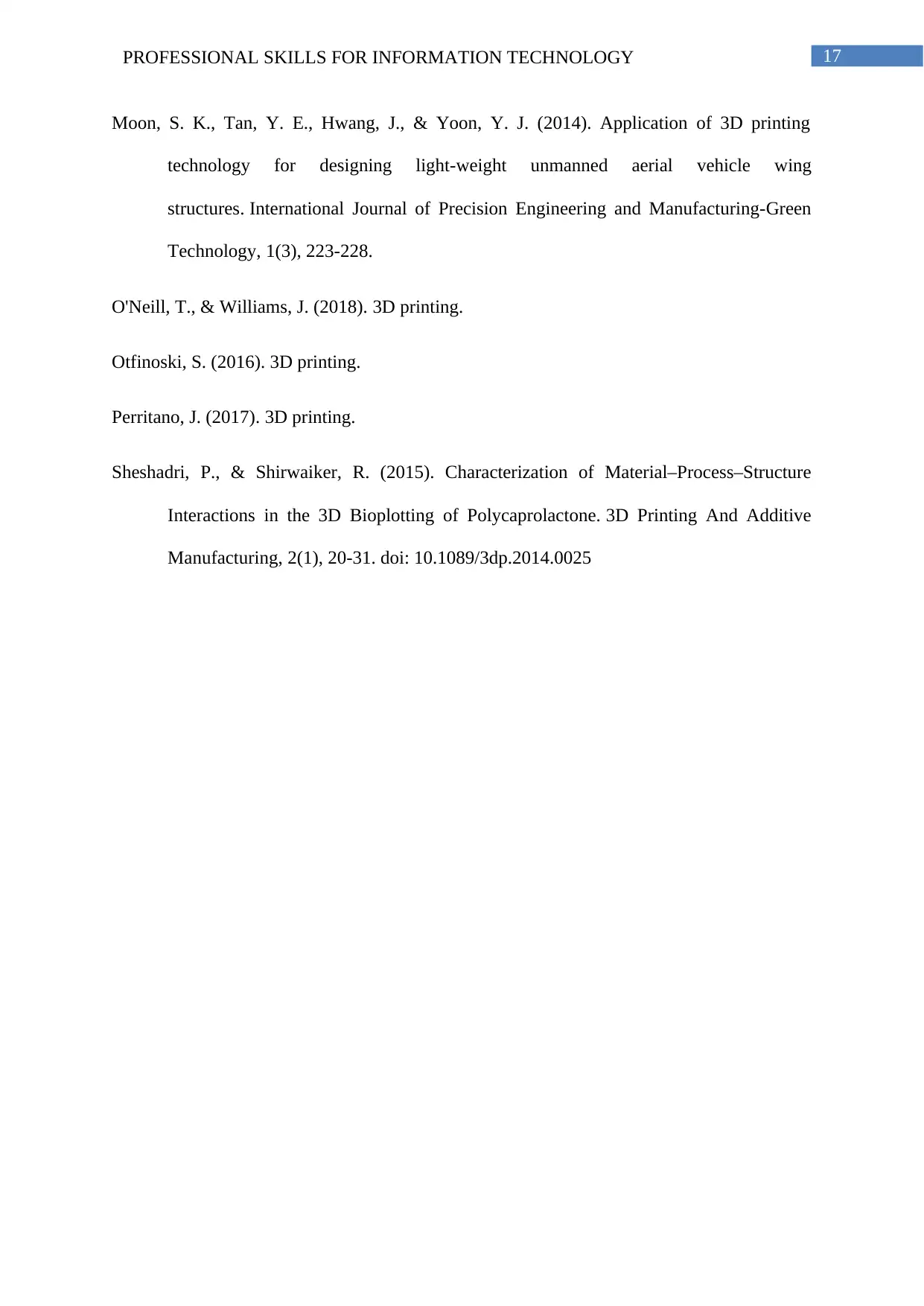
17PROFESSIONAL SKILLS FOR INFORMATION TECHNOLOGY
Moon, S. K., Tan, Y. E., Hwang, J., & Yoon, Y. J. (2014). Application of 3D printing
technology for designing light-weight unmanned aerial vehicle wing
structures. International Journal of Precision Engineering and Manufacturing-Green
Technology, 1(3), 223-228.
O'Neill, T., & Williams, J. (2018). 3D printing.
Otfinoski, S. (2016). 3D printing.
Perritano, J. (2017). 3D printing.
Sheshadri, P., & Shirwaiker, R. (2015). Characterization of Material–Process–Structure
Interactions in the 3D Bioplotting of Polycaprolactone. 3D Printing And Additive
Manufacturing, 2(1), 20-31. doi: 10.1089/3dp.2014.0025
Moon, S. K., Tan, Y. E., Hwang, J., & Yoon, Y. J. (2014). Application of 3D printing
technology for designing light-weight unmanned aerial vehicle wing
structures. International Journal of Precision Engineering and Manufacturing-Green
Technology, 1(3), 223-228.
O'Neill, T., & Williams, J. (2018). 3D printing.
Otfinoski, S. (2016). 3D printing.
Perritano, J. (2017). 3D printing.
Sheshadri, P., & Shirwaiker, R. (2015). Characterization of Material–Process–Structure
Interactions in the 3D Bioplotting of Polycaprolactone. 3D Printing And Additive
Manufacturing, 2(1), 20-31. doi: 10.1089/3dp.2014.0025
1 out of 18
Related Documents
Your All-in-One AI-Powered Toolkit for Academic Success.
+13062052269
info@desklib.com
Available 24*7 on WhatsApp / Email
![[object Object]](/_next/static/media/star-bottom.7253800d.svg)
Unlock your academic potential
© 2024 | Zucol Services PVT LTD | All rights reserved.




